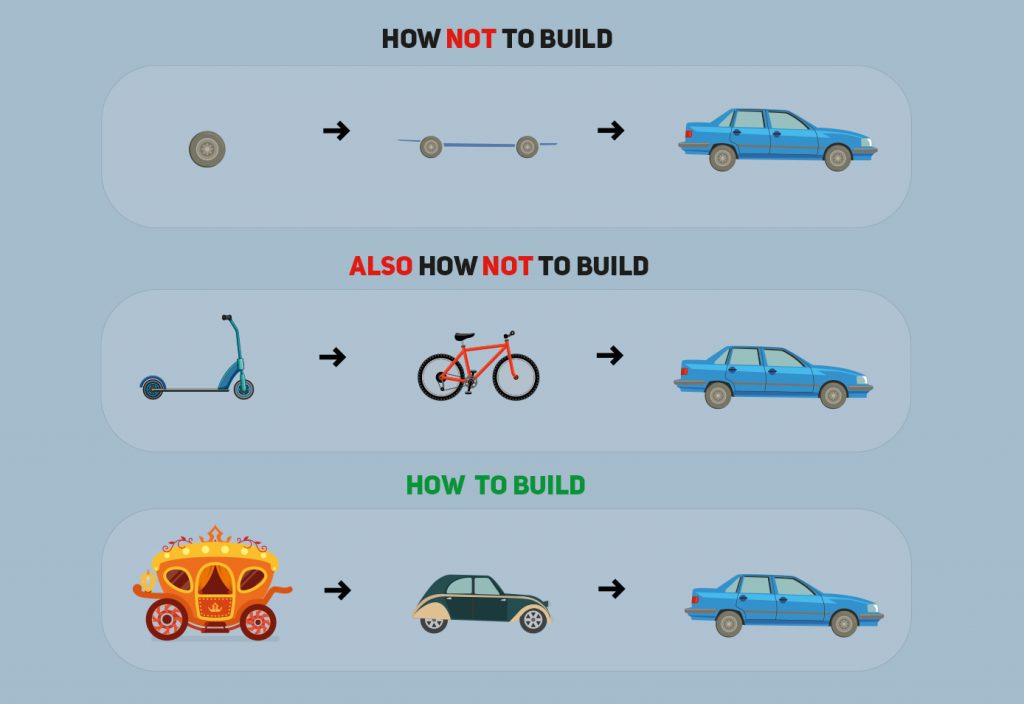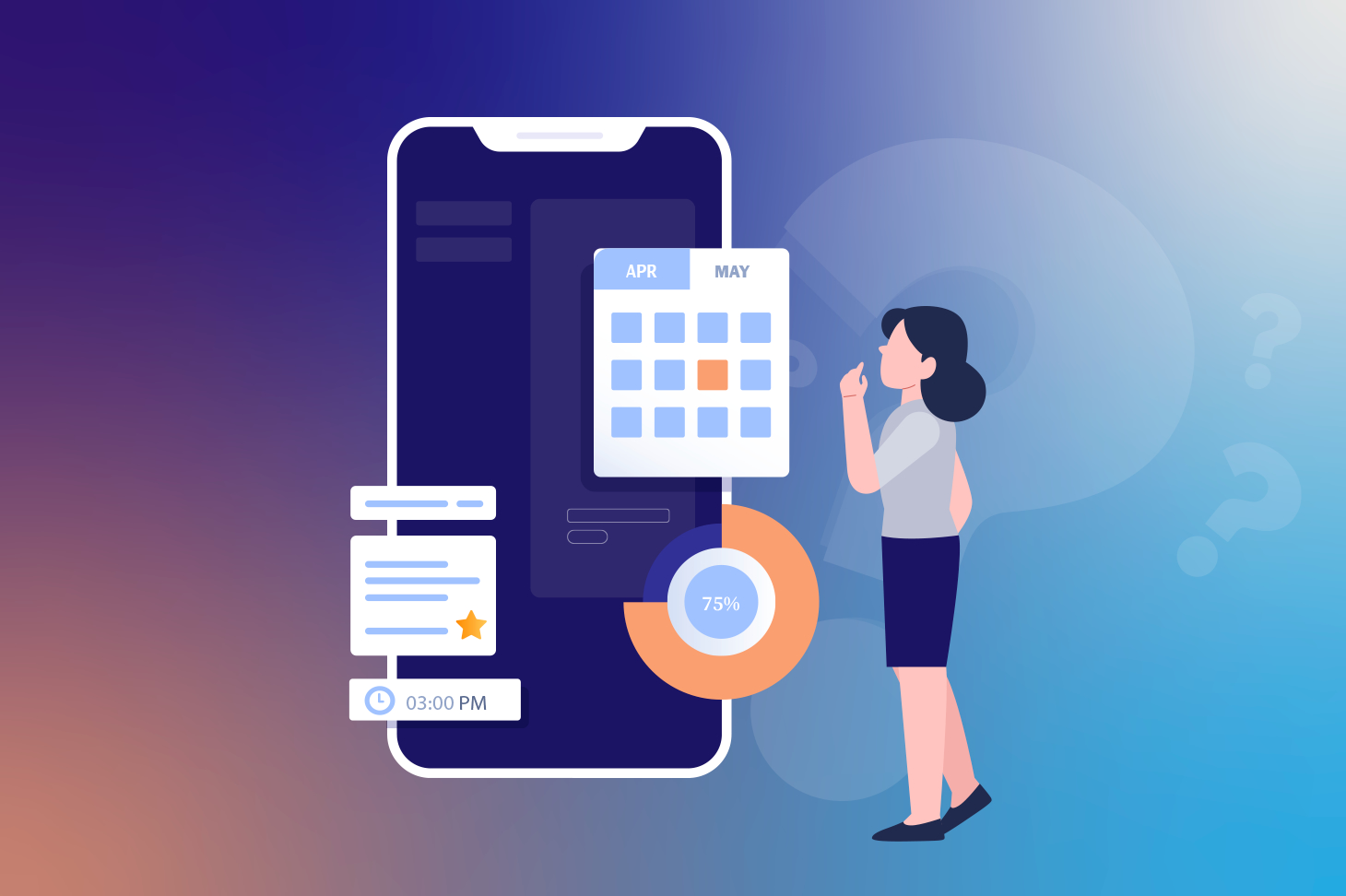Contents
Startups and large IT companies are increasingly using the MVP as a starting point for creating a good software product. Organizations develop a product foundation based on a minimum key features set. And if they turn out to be effective and viable in the market, they contribute to the offerer scaling and the full-fledged product creation.
According to CB Insights research, in 42% of cases, the reason a startup fails is the lack of market demand. In almost half of the cases, entrepreneurs spend months or even years of work only to realize that the hypothesis was wrong and no one is interested in their product.
In this article we will talk about the key aspects and benefits of launching an MVP, and why MVP development is important.
MVP Goals
Gathering information through MVPs is much cheaper than developing a full-fledged product with a large features set. MVP allows businesses to reduce costs and risks many times over, and, with the right approach, come up with a business idea that works. A minimally viable solution needs to prove economic feasibility. Development speed can only be prioritized if the MVP analysis and testing goals are achieved quickly.
Thus, the primary MVP goals are:
- Evaluate product hypotheses with minimal resources
- Accelerating the information needed to create a solution
- Create a basis for analyzing user behavior and needs to decide which direction to take the business further
- Saving development time for the team, quickly getting the project to a “workable” state
- Quickly deliver a product that solves at least one problem to early users
- Create a foundation for other projects
- Attracting investors and opening up crowdfunding opportunities
The MVP takes into account the needs and preferences of users, but they don’t directly determine the product development direction. Project vision mostly already exists, and it will be maintained throughout its lifecycle. The MVP is created to test a market need, and if it doesn’t exist, to try to create one. Entrepreneurs and developers usually form their idea of the purpose and MVP essence depending on their business goals.
MVP Key Aspects
A fast and high-quality MVP launch allows to instantly bring a product to market, test ideas in practice, and get real-time user reactions to the overall product concept. However, it is not only for product improvement, but also to save a tremendous amount of work. A minimally viable product helps decide if and how to further develop a product or service idea and is only effective when the business listens to the feedback it receives. Anyway, the MVP has several key aspects:
- Minimum viable product is not viable until it makes a profit or shows growth in its user base, thereby increasing its value.
- The MVP must show enough promise for the future to retain its first customers even months and years later.
- The MVP should have feedback to determine future development strategies. If the product does not live up to expectations, there should be an opportunity to change course or assess which points need refinement first.
- Minimum viable product’s main thing should be key features, enough to implement the idea and keep early adopters. Exactly how many of them, one or ten is unimportant.
- The MVP concept is based on the lean startup philosophy and involves an iterative process of building, measuring and learning. The cycle will repeat as long as the product fully satisfies market needs.
- Minimum viable product seeks to avoid creating unnecessary, useless products by first gaining insight into user needs and interests.
How to Develop an MVP?
Chasing the ideal and improving the product can be endless, and no one has cancelled the Pareto principle. 80% of your customers are likely to use only 20% of the functionality. They may have enough of what they have or, on the contrary, need completely different features. So it is important to focus on this 20% of the functionality.
The MVP is created specifically to test basic assumptions. Could it be something that people are interested in? If so, then the startup can develop its activities further.


Steps to develop an MVP
- First, you need to define the problem product solves and its main task. Also, try to spend as little money and effort as possible. After all, the main idea of the MVP is to reduce the time and resources to test the business concept.
- Then test your hypothesis through communication with potential customers. Select a specific audience and make a detailed customer description. Insights into your audience’s lifestyles will help you understand if the product will solve the problems customers face.
- Do your research on the market and competitors. Gather information, study statistics to note strengths and weaknesses, assess prospects, and make a product that will stand out from the rest.
- Next, create a list of all features that should be in the product for its viability. Then prioritize them in descending order, marking the most important ones at the beginning. So you can understand what to emphasize, and what you can avoid.
- Find a suitable method of MVP management and development, because the choice of method depends on the objectives. There are several methods of MVP software development. These are Lean, Scrum, Extreme Programming (XP), and Kanban.
- And then you need to create an MVP – a minimal idea version to test it in practice. Run the first test version for a narrow group of consumers, such as friends, acquaintances, or relatives. This is alpha testing. If there are no defects, you can move on to beta testing. Offer the product to real consumers. After that collect and analyze the feedback. Refine the MVP and test it again. The length and number of testing cycles depend on the product and how quickly a complete solution can be created.
- Test the effectiveness of the product, add features that are in demand, and gradually go to a more complete version of the product.
MVP Development Failures
Miscalculations can also arise from difficulties encountered during testing. The main problems in this direction can include the following issues.
- Because of the desire to make the product perfect, it is possible to do nothing at all. That’s why it’s important to understand that developing a product with a basic package is creating a good, working model, not a ready-made version with a large set of functionalities.
- Guided not only by the desire to implement the idea, but also by real numbers. It is important to conduct an interim analysis of the results achieved, without waiting for the final release.
- A hastily done job becomes a big problem already at the testing stage. Consumers can’t evaluate even the minimum set of features, which means companies can’t fully collect feedback. Because it is based on the feedback that the initial version is finalized. Without it, businesses will not understand the strengths and weaknesses of the concept, nor assess the existing problems.
- A good UX is a must when creating any product in principle. Without it, the whole MVP can show that the project doesn’t meet the audience’s expectations. While the only problem is the UX, and the rest of the product works quite well.
- You should not promise various contrived features to attract the attention of customers. Promises should be realistic and deliverable. Disappointed audiences and deceived expectations will lead nowhere.


Examples of Famous Companies MVPs
Almost all successful startups in the West start their way to success with MVPs. This is the least dangerous and most costly approach. Another option is to separate the project from a larger company, or to develop a large product after attracting solid investment. Most famous startups started with a simple MVP version, tested the market, recruited a customer base, showed investors their idea. Only then did they add new features to the product and continue to build on the success.
Dropbox
Dropbox first shot a demo video where they presented their idea in 3 minutes. There was no product as such yet. The video got likes, millions of views, thousands of comments, and helped attract investors.
Snapchat
The service from the beginning had a small utility for sharing messages that deleted after 10 seconds after being read. The first iOS version came out in 2011, with more advanced features, including image uploading. Now Snapchat has 230 million users every day. The company itself is valued at $35 billion.
Airbnb
Sometimes it’s enough to take one step and get feedback to test the viability of an idea. In 2007, Brian Chesky and Joe Gebbia saw a need for short-term low-cost rentals. At the time, they were living in San Francisco and found that in a city that hosts a lot of conferences, there were no options for overnight stays other than expensive hotel rooms, and it was a challenge to book a room in them. To pay for the apartment they were staying in, Brian and Joe created an ad on a website for shared rentals. Afterward, three members of one of the conferences responded to the offer. This became the starting point for founding an online platform for finding and listing short-term rentals around the world.
The company’s MVP helped Brian and Joe see the validity of the hypothesis and start growing the business. In 2020 Airbnb had a turnover of $3.38 billion and more than 5,500 employees.
Foursquare
At first, there was only one feature in the app – “checkout”. Plus rewards for checks in the form of badges. Only after the application was rich enough and received feedback did the developers begin to expand its functionality. Now Foursquare is used by more than 55 million people, and the value of the service exceeds $240 million.
Unsplash
The stock photography platform started as a blog on Tumblr. Their users could download a theme and ten high-quality photos from local photographers for $19. To find people interested in the project, the news was placed on Hacker News. In the first hours after it was posted on Unsplash, more than 20,000 photos were uploaded. The first site was primitive, and photos you could upload to it through a Dropbox account. It was impossible to work with this scheme for a long time, so Unsplash quickly began to transform. Today, the online platform brings together more than 207,000 photographers and adds two million photos each month.
Uber
Garrett Camp and Travis Kalanick launched the UberCab iPhone app in 2010, where passengers could rent premium cars at half the price of a regular cab. The creators came up with the idea after they noticed that city cab fares had become disproportionately high. The app initially worked on a limited territory and with a narrow target audience, but after a year of beta-testing, the creators were able to attract the first major investments.
Conclusion
A startup always starts with an idea. And even if the idea is unique, it is worth checking for viability and relevance. Developing a product MVP will help you save money and at the same time gather the necessary information. So, don’t underestimate a good viable product. It will help save time and money. Many examples have allowed creators to attract investment for product development.





